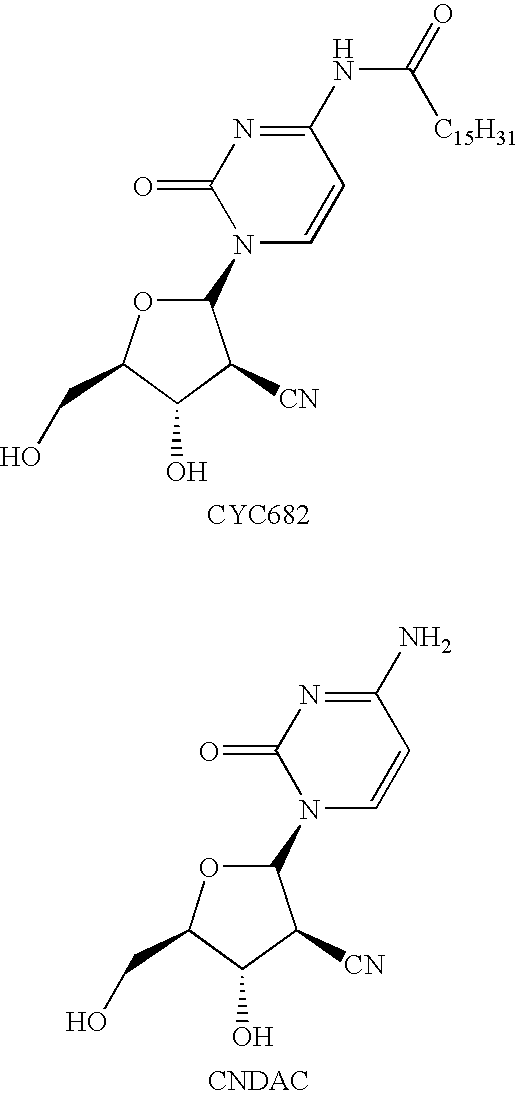Methods of treatment using sapacitabine
a technology of sapacitabine and treatment method, which is applied in the field of treatment method using sapacitabine, can solve the problems of insufficient prior art teaching to suggest the effectiveness of sapacitabine, and achieve the effects of improving storage stability and ease of handling, excellent anti-tumour activity, and desirable pharmacokinetic profil
- Summary
- Abstract
- Description
- Claims
- Application Information
AI Technical Summary
Benefits of technology
Problems solved by technology
Method used
Image
Examples
example 1
[0215]The B-form of sapacitabine was prepared in accordance with the methodology described in EP 536936 and EP 1364959, both in the name of Sankyo Company Limited.
Capsule Preparation
[0216]Liquid fill capsules were prepared in accordance with the methodology described in PCT / GB2006 / 004927 (Cyclacel Limited).
[0217]The drug is supplied as 25 mg and 75 mg opaque white, gelatin capsules. This formulation comprises liquid-filled capsules of a sapacitabine-B crystalline form in miglyol 812N. Capsules are packaged in high-density polyethylene bottles (50 capsules per bottle), with low-density polyethylene screw-cap, child-resistant closures. The higher strength was formulated to fill into a size 1 capsule, while the lower strength was formulated to fill into a size 3 capsule as appropriate. All materials are of pharmacopoeial quality. A summary of the formulation components is provided in the table below.
[0218]
Formulation Capsule (mg / capsule)Unit FormulaIngredient25 mg75 mgSapacitabine B Fo...
example 2
7-Day / 14-Day Dosing Regimen in the Treatment of Refractory Solid Tumours or Lymphomas
[0235]The study was conducted at the Institute for Drug Development, Cancer Therapy and Research Center (CTRC) in San Antonio, Tex. and Fox Chase Cancer Center in Philadelphia, Pa. The primary objective of the study was to evaluate the safety profile of sapacitabine administered twice daily for 14 consecutive days or 7 consecutive days every 21 days.
Study Design
[0236]The study was an open label dose escalation study of oral sapacitabine administered twice daily (b.i.d.) for 7 or 14 consecutive days every 21 days. One treatment cycle was 3 weeks. At least 3 patients were enrolled at each dose level. Dose escalation proceeded if ≦⅓ or ≦ 2 / 6 patients experienced dose limiting toxicity (DLT) during the first treatment cycle.
Dose Limiting Toxicity (DLT), Maximum Tolerated Dose (MTD) and Recommended Dose (RD)
[0237]DLTs are any of the following toxicities occurring during the first treatment cycle and judg...
example 3
7-Day Dosing Regimen in the Treatment of Advanced Leukemias or Myelodysplastic Syndromes
[0248]The Phase I study was conducted at M.D. Anderson Cancer Center (UTMDACC) in Houston, Tex. The primary objective was to define the MTD of a dosing schedule, b.i.d.×7 days orally every 21 days.
Eligibility
[0249]Eligible patients had relapsed / refractory leukemias or MDS, or untreated disease if not willing to proceed with conventional systemic chemotherapy, adequate organ functions and performance status of 0-2. At least 3 patients were enrolled at each dose level. The MTD was the highest dose level at which ≦ 2 / 6 patients experienced a DLT during the first treatment cycle.
Results
[0250]Forty-seven patients received sapacitabine, including 35 treated with the 7-day schedule. Median age was 65 (range: 36-91). The majority of patients had AML (n=36) or MDS (n=4). Median number of prior chemotherapies was 2 (range: 0-6). Cytogenetic abnormalities were present in 27; 30 had relapsed disease or were ...
PUM
| Property | Measurement | Unit |
|---|---|---|
| time | aaaaa | aaaaa |
| time | aaaaa | aaaaa |
| time | aaaaa | aaaaa |
Abstract
Description
Claims
Application Information
 Login to View More
Login to View More - R&D Engineer
- R&D Manager
- IP Professional
- Industry Leading Data Capabilities
- Powerful AI technology
- Patent DNA Extraction
Browse by: Latest US Patents, China's latest patents, Technical Efficacy Thesaurus, Application Domain, Technology Topic, Popular Technical Reports.
© 2024 PatSnap. All rights reserved.Legal|Privacy policy|Modern Slavery Act Transparency Statement|Sitemap|About US| Contact US: help@patsnap.com








